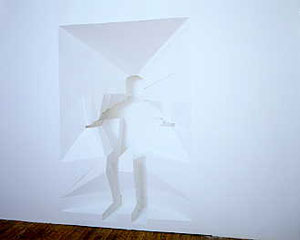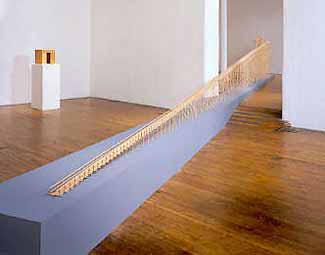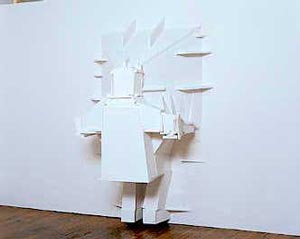| If
the world does not exist without us then it can be thought of as an extension
of ourselves, expressed in systems. It has to be thought of that way anyway,
since we are the ones thinking it. Architecture is the most basic of these systems,
essentially because it involves establishing a place for ourselves, or oneself,
whether one is an architect or not. Of course, architecture is inevitably mediated
and determined by other systems--religious, social, political, commercial, musical,
chemical, etc.--but none of these is as immediate or physical as architecture,
which is materially coexistent with us and can be touched. Walls, floors, and
ceilings measure our space, our limits, just as other systems do immaterially.
The more we know, the more limits we have, and architecture literally defines
our limits. |

Too Large Table, 2002. Wood and sheetrock, 33" x 192" x 192". |
| A dome represents
the sky, the universe, less accurately, perhaps, than what we have come to know
about the shape of the universe since the dome was invented, but accuracy is
not necessarily the point. We are surrounded and extended by buildings and groups
of buildings, within which we devise an epicenter (the décor of our private
space and thought) from which unfold our relationships to everything beyond us.
We are reminded that the closer one comes to reconciling self and non-self, the
further one is from actually achieving reconciliation. For one thing, we come
up against the very materiality that is so comforting. The alternative to maintaining
distinctions is confusing self and non-self, which we label paranoid schizophrenia.
|
| Allan Wexler's work assumes the form of heroically practical attempts to bridge the gap. It is both comedy and tragedy that the contradictions become even more pronounced, that our existence is also our isolation. Too Large Table (16 feet b y 16 feet) is too large because there are too many possibilities for interaction and non-interaction, and it is impossible to reconcile so many possibilities, except that they all take place at the same flat, horizontal expanse of the table. Thirteen chairs are part of the structure and actually hold the table up. When people are seated in the chairs they can look at and talk to the person opposite or perhaps even at an angle, and basically communication is both anarchic and mathematically determined by the diagram of the table itself. Still, the table could be, and of course in our experience is, even larger. Proposal for Utopian Café (round), a small model for a lifesize project, solves the problems of unity and conformity by having chairs in a circle holding up a circular canopy. Now everyone looks toward the center and plays an equal role in supporting the roof, by which they are unified. But new problems are introduced. Everyone looks inward rather than outward, which may have pertinence in some modes of thought, but still involves turning one's back on the outside. This is partly solved, with both new and familiar difficulties, in Proposal for Utopian Café (square), in which the chairs still hold up the canopy but are arranged in the more individualistic mode of Too Large Table. |
 Wall (I Want to Become Architecture). Concave side. |
| Of course, the organic human form, which Wexler never actually depicts, is an intractable problem in itself, as it always has been in the geometry of art. It can twist and turn and even stand on its head; it doesn't really fit any system, though it must. It is soft, architecture is hard. It is variable and changeable, architecture is precise and eternal (for a while). The conjunction is found in Wall (I Want to Become Architecture), an illustration of architectural ego, perhaps, but beyond that a realization that there is a transition between the two realms and that the transition can never be completed no matter how refined the process or system, computerized or otherwise. The figure, here again seated and seen as concave on one side of the wall and convex on the other, will always retain, like a Cubist painting, the planar and geometric elements of the wall. It adheres to a system created by the artist of the artist created as a system from the wall. It is the wall, defined by its wallness. Wexler counters encapsulation with escape mechanisms, such as Incomplete Continuous Stair, the model for the stairwell of a possibly endless skyscraper, and Ramp, a five-inch-wide pathway that rises over a 48-foot-long structure. Both seem to reach into some unknown space; both would continue forever, but they can only suggest that. They would like to present a straight line into those spaces, particularly Ramp with its upward path of vision, but they can't because the materials and the method of construction, or probably any method of construction, won't allow it. Ramp has a wonderful, romantic latticework of wooden members scaled to what would be two-by-fours in an actual ramp, but, of course, the whole thing would collapse as the ramp reached beyond a certain height. As it is, the entire structure has an uneven, rickety quality that characterizes both its aspirations and its possibilities. Nonetheless, the process of building extends as far as it can. |
| All of Wexler's work has the obsessiveness of child's play--the belief in and repetition of thought patterns as long as they work. There is also an insistence in the process of getting somewhere, which takes child's play into the area of scientific inquiry. It wants to reach a conclusion but can't, which means it has been art all along. --Donald Goddard © 2001 |
 Ramp, 2001. Wood, 5" x 48'. |
| Photos Courtesy of Ronald Feldman Gallery The exhibition ran from March 23 through April 20, 2002, at Ronald Feldman Fine Arts, 31 Mercer Street, New York, NY 10013. Tel. 212 226 3232. Fax 212 941 1536. |
